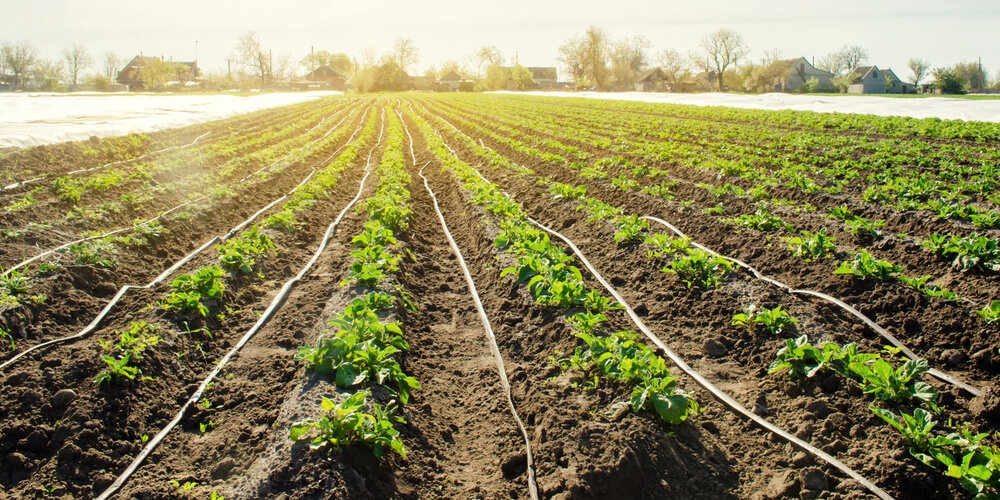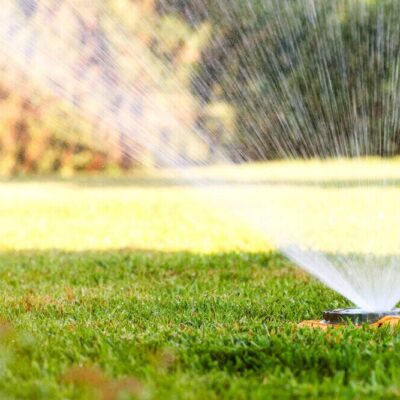The amount of irrigation water that is needed to efficiently water plants and crops is dependent on the crop, the climate in which the plants or crops are grown, and the type of irrigation technique employed.
In the same way as with a home garden, there are various designs of sprinklers, some of which are more efficient than others. Also, in various parts of the world, flood or surface irrigation is used, whereby water is delivered and flows across a field, and soaks into the ground.
Flood or Surface Irrigation
In terms of farming on the global stage, agriculture accounts for 70% of the Earth’s freshwater resources. Of this 70%, 95% of farmers turn to flood or surface irrigation.
Unfortunately, flood or surface irrigation is the least efficient method. It's because it delivers more water than the plants need. Much of the water is lost as it evaporates into the atmosphere, while that which is excess to the plants’ requirements percolates down to groundwater.
This type of irrigation also doesn't apply water evenly across the field, resulting in some plants getting too much water while others don't receive enough.
In general terms, this type of irrigation wastes 50%+ of water delivered.
But the one positive for flood or surface irrigation is that it requires less energy and hardware and is, therefore, usually cheaper than any other method to install and run.
The methods of flood or surface irrigation can be broken into three categories – basin, border, and furrow.
Basin Irrigation
Basin irrigation describes a method whereby the growing area is level and surrounded by dikes. The growth areas can be anywhere from just a few square feet to several hundred. The soil in the areas might be "corrugated" in order to try and promote a more uniform delivery of the irrigation water.
The dikes that enclose the basin must be stable enough to prevent breaching. Because the areas to which basin irrigation is applied have only a slight slope and have closed boundaries, this type of irrigation is best suited to crops that have a high inundation tolerance, - crops like varieties of rice grown in paddy fields.
Border Irrigation
Border irrigation is like basin irrigation in as much as it transports water across entire growing areas or fields. But with border irrigation, the fields are usually wide, rectangular, and are sloped away from the water source.
The growth/irrigation area is divided into sloping borders and has a ditch running along the side with the highest elevation. The water flows down the field and is drained out or captured at the lower end.
Typically, this type of irrigation is used on forage crops like alfalfa, wheat, and row crops that don’t like standing water. It’s best suited for use with fields that have a moderately low to high water intake rate, as the water has less of a tendency to puddle.
Furrow Irrigation
The soil for furrow irrigation areas is laid out with ridges between which furrows run. Crops are planted in the ridges, and the irrigating water is introduced directly into each furrow via small pipes or hoses. It then runs down the sloped furrows aided by the force of gravity, seeping down into the root zone of the crops as it goes.
This irrigation method is best used in annual row crop agriculture where the soil has an acceptable intake rate so as to prevent water puddling on the soil surface.
Surface Irrigation Inefficiency
The efficiency (or inefficiency) of surface irrigation averages around 50 to 60%. In other words, 40 to 50%+ of the water is wasted due to deep percolation beneath the crop root zone or through run-off. However, this waste can be lessened by more accurate grading of land, adjusting the water inflow, optimising the timing of irrigation, and capturing and reusing run-off.
But, in the final reckoning, surface irrigation remains considerably less efficient than pressurised irrigation systems such as drip or sprinkler irrigation.
Pressurised Irrigation Systems – Drip & Sprinkler Irrigation
With a pressurised irrigation system, water is pressurised and delivered more precisely to crops via a system of pipes as opposed to surface irrigation. Pressurised systems facilitate improved farm distribution, better control with timing, less land wastage in terms of field utilisation, requires less labour, and uses limited water resources much more efficiently.
The two most commonly used pressurised systems are drip and sprinkler, with each one having various options according to the type of field, crop, and the type of fittings. Essentially, these systems comprise a control station, a system of pipes, manifolds, and delivery pipes emitters or spray booms and centre-pivot systems. These systems can also incorporate fertiliser injectors for fertigation.
Efficiency Potential of Pressurised Systems versus Surface Irrigation
Whereas surface irrigation has an efficiency of only between 50% and 60%, pressurised irrigation systems can have an efficiency rating between 75% and 95% when configuration is optimised. They also require much less time in terms of manual maintenance – from one-tenth to one-quarter of the time required for surface irrigation solutions.
However, the technology associated with pressurised irrigation systems makes them much more costly to purchase and install – far beyond the financial reach of the farmers of small holdings in developing nations.
Other important factors when considering pressurised irrigation systems include the quality of water and the availability of appropriate energy supplies. If the local water supply contains a high proportion of dissolved minerals, it will frequently cause the emitters to become blocked. In these circumstances, routine maintenance is necessitated to clear blockages and maintain the pumps and any fertigation units. Also in some areas, mains electricity is not available.
Example - the Grand Valley of Western Colorado
The irrigation network in the Grand Valley of Western Colorado is almost entirely gravity-fed, with the area being easy to flood via furrow irrigation without the need for pumps. Also, the majority of the fields are small, and the soil is clayey, making the use of centre-pivot machinery extremely challenging.
Yet, in the same area, there are peach orchards where drip system and micro-spray technology is utilised. The result is considerably reduced water consumption and improved crop yields thanks to irrigation water being applied directly to the crop when needed.

Types of Pressurised Irrigation Systems
Pressurised irrigation systems vary from highly sophisticated computer-managed systems with heavy start-up costs, to more moderately costly systems such as bubblers and mini and micro-sprinklers suitable for orchards, but which can only be afforded by large and commercial farmers.
However, less costly pressurised systems have become more popular with some smallholders – systems such as drip tape, drip emitters, porous-walled pipes, and mobile hose sprinklers.
Predicted Growth of the Global Drip Irrigation Market
Drip irrigation, alternatively known as trickle irrigation, means dripping water at very low rates – around 2 to 20 litres of water per hour, using a system incorporating small diameter plastic pipes to which emitters or drippers are fitted.
The water is delivered adjacent to the plants, directly onto the soil in which the crop roots grow, rather than using surface or sprinkler irrigation, which moistens the entire soil profile, minimising the likelihood of evaporation. The applications of drip irrigation are more frequent, normally every one to three days. This causes a high moisture level, enabling crops to flourish.
The global drip irrigation system market is mostly driven through efforts to attempt to increase farming productivity while at the same time optimising efficient water usage.
According to the sphericalinsights.com website, a report issued in April 2023 shows the following in terms of growing demand:
| Year | Global Drip Irrigation
Market Value |
| 2021 | $5.2 billion |
| 2022 | $6.19 billion |
| 2023 | $6.76 billion |
| 2024 | $7.38 billion |
| 2025 | $8.05 billion |
| 2026 | $8.79 billion |
| 2027 | $9.59 billion |
| 2028 | $10.47 billion |
| 2029 | $11.43 billion |
| 2030 | $12.48 billion |
Depending on application, the drip irrigation market is segmented into two types – surface and sub-surface. The surface segment is forecast to grow the most as these types of systems are becoming increasingly popular thanks to their lower installation and maintenance costs.
Surface irrigation is often used for irrigating perennial and annual row crops. In addition, the Asian market dominates the surface segment and is predicted to grow at the quickest rate in the next few years.
The global drip irrigation market is split into various sections comprising drippers/emitters, drip tubes/drip lines, fittings & accessories, filters, pressure pumps, and valves. Of these, it’s the emitters/drippers component which accounts for the largest majority share, and this is forecast to dominate the segment across the estimated period thanks to benefits like no water clogging.
In addition, increased technological advancement in emitter design by manufacturers due to increased demand from both the residential and agricultural market sectors is predicted to fuel the rising trend.
Sources
https://www.agrivi.com/blog/modern-management-of-centennial-furrow-irrigation/
https://extension.okstate.edu/fact-sheets/surface-irrigation-systems.html
https://serc.carleton.edu/integrate/teaching_materials/food_supply/student_materials/1096
https://civiltoday.com/water-resource-engineering/irrigation/269-types-of-irrigation-methods


